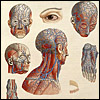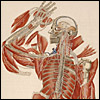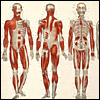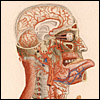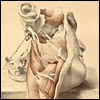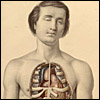
Another Reality
The Colorized Human Project
By
the late 1700s, the commitment to empirical representation of the body
was increasingly asserted by an obsessive attention to detail that went
beyond realism. The anatomy of the 1800s featured fine line, rich texture,
and, in much of the material, intense color. In realistic rendering, detail
is often obscured—the eye can’t make certain things out.
In the hyper-realism of the new anatomy, detail stands out in shocking,
dream-like clarity, a demanding visual effect that requires sophisticated
artistry and a deeper understanding of bodily structure and function derived
from pathological anatomy. In much of hyper-realist anatomy, the image
is a composite, idealized, and beautified body; the process of dissection
and setting of the anatomy room are suppressed as an unnecessary distraction.
Monumental
Books
Beautiful
Ugliness: Bidloo
Another Reality
Next Section: Visionary and Visible
U.S. National Library of Medicine, 8600 Rockville Pike, Bethesda, MD 20894
National Institutes of Health, Department of Health & Human Services
Copyright, Privacy, Accessibility
Last updated: 8 March 2004
|
Timeline: Technologies of Anatomical Representation 1300s Woodcut printing brought from China to Europe, used to print textiles 1400s Paper becomes available in Western Europe 1423 Earliest known European woodcut print on paper 1452 Copperplate engraving invented 1450s Moveable type invented; Gutenberg Bible printed (1455) 1491 First illustrated printed medical book published in Venice, Johannes de Ketham, Fasciculus Medicinae 1543 First profusely illustrated anatomy, Vesalius, De Humani Corporis Fabrica 1620s First multi-color printed illustrations 1630s Etching invented 1642 Mezzotint invented by Ludwig von Siegen, a German army colonel 1740s Mezzotint color printing method perfected 1780s Thomas Bewick develops modern technique of wood engraving 1798 Lithography invented in Solnhofen, Germany by Alois Senefelder 1837 Daguerre invents first practical photographic method 1895 Roentgen demonstrates x-ray imaging
More Information on Technologies of Anatomical Representation |
